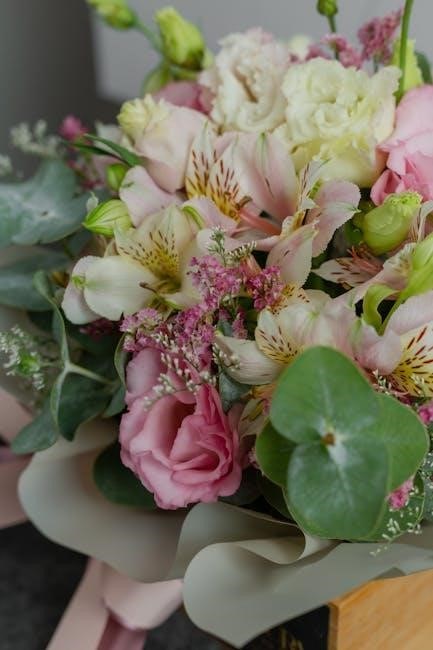The Rose Guide to the Tabernacle explores the tabernacle’s history, structure, and symbolic meanings. It provides a detailed overview of its significance in biblical worship and context.
1.1 Overview of the Tabernacle
The tabernacle, a portable place of worship, was constructed under Moses’ guidance as a sacred space for God’s presence. Its design, detailed in Exodus, included three main sections: the Holy of Holies, the Holy Place, and the Outer Court. Built with materials like gold, linen, and acacia wood, it symbolized God’s covenant with Israel. The tabernacle served as a center for sacrificial rituals and divine worship, emphasizing purity and reverence. Its structure and furnishings held deep symbolic meaning, reflecting God’s holiness and humanity’s need for atonement. This sacred tent was both a physical and spiritual focal point for Israel’s relationship with God.
1.2 Historical Background
The tabernacle was constructed during the Israelites’ wilderness journey, following their exodus from Egypt. Moses received detailed instructions for its design and construction on Mount Sinai. Built around 1446 BCE, it served as a mobile worship center, symbolizing God’s presence among His people. The tabernacle was central to Israel’s religious life until the construction of Solomon’s Temple in Jerusalem. Its history reflects the covenant relationship between God and Israel, emphasizing sacrifice, atonement, and divine guidance. This sacred structure bridged the earthly and heavenly realms, showcasing God’s desire to dwell among His people.
1.3 Significance in Biblical Context
The tabernacle was the central place of worship for the Israelites, symbolizing God’s presence among His people. It represented the covenant relationship and served as a reminder of God’s redemption. The tabernacle’s design and rituals foreshadowed Christ, with its sacrifices and priesthood pointing to His atoning work. It also symbolized heaven, emphasizing worship, atonement, and divine fellowship. The tabernacle’s significance lies in its role as a temporary dwelling place for God, bridging the earthly and heavenly realms, and its enduring typology in Christian theology, highlighting God’s plan of salvation and His desire to dwell with humanity.

Structure of the Tabernacle
The tabernacle consisted of three main sections: the Outer Court, the Holy Place, and the Holy of Holies. Each area served distinct sacrificial and priestly functions, reflecting divine order and purpose.
2.1 The Outer Court
The Outer Court was the tabernacle’s outermost section, accessible to all Israelites. It contained the Bronze Altar for sacrifices and the Bronze Laver for priestly purification. Constructed with bronze and fine linen, it symbolized judgment and cleansing. The court represented the first step in worship, emphasizing communal sacrifice and purification before approaching God. Its design reflected divine order and accessibility, serving as a public space for ritual and atonement. The Outer Court’s elements underscored the necessity of purity and sacrifice in worship, aligning with biblical principles of holiness and community involvement.
2.2 The Holy Place
The Holy Place, located inside the tabernacle, was a sacred area accessible only to priests. It housed the Golden Lampstand, the Table of Showbread, and the Altar of Incense. These items were crafted with gold, symbolizing divine presence and holiness. The Golden Lampstand provided light, representing God’s wisdom and guidance. The Table of Showbread held twelve loaves, symbolizing God’s provision and covenant with Israel. The Altar of Incense was where priests offered prayers and incense, creating a fragrant offering to God. These elements emphasized worship, communion, and the priests’ mediatorial role, bridging heaven and earth in sacred rituals.
2.3 The Holy of Holies
The Holy of Holies was the most sacred chamber in the tabernacle, separated from the Holy Place by a thick veil. It housed the Ark of the Covenant, surmounted by the Mercy Seat, where God’s presence dwelled. Only the High Priest could enter once a year on Yom Kippur to atone for Israel’s sins. This sacred space symbolized God’s throne room and humanity’s separation from divine holiness. The rituals performed here emphasized sin’s gravity and the need for atonement, foreshadowing Christ’s ultimate sacrifice. Its design and restrictions underscored the awesomeness of God and the necessity of mediation in worship.
Key Components of the Tabernacle
The tabernacle’s key components include the Ark of the Covenant, the Mercy Seat, the Table of Showbread, the Golden Lampstand, the Altar of Incense, the Bronze Altar, and the Bronze Laver. These items were crafted with precise materials and symbolic designs, reflecting their sacred purposes in worship and atonement. Each component played a vital role in the tabernacle’s function as a place of divine encounter and sacrificial worship.
3.1 The Ark of the Covenant
The Ark of the Covenant was a sacred wooden chest overlaid with gold, constructed according to divine instructions. It featured two cherubim made of gold on its lid, symbolizing God’s presence. Inside, it held the Ten Commandments, Aaron’s rod, and a jar of manna, representing God’s covenant and provision; The Ark served as the earthly throne of God, where He dwelled among His people. Its lid, the Mercy Seat, was the site of atonement rituals. The Ark signifies God’s holy presence and the importance of obedience, foreshadowing Christ’s role as humanity’s mediator and redeemer.
3.2 The Mercy Seat
The Mercy Seat, or the lid of the Ark of the Covenant, was a golden slab where God’s presence manifested. It featured two cherubim facing each other, symbolizing divine guardianship. The high priest sprinkled blood here during Yom Kippur, making atonement for Israel’s sins. The Mercy Seat represented God’s grace and mercy, where sin was covered. It signified the meeting point between a holy God and sinful humanity, emphasizing the necessity of atonement. This sacred object foreshadowed Christ’s role as humanity’s mediator, ultimately fulfilling the need for atonement through His sacrifice.
3.3 The Table of Showbread

The Table of Showbread was a sacred furnishing in the Holy Place, made of acacia wood overlaid with gold. It held twelve loaves of unleavened bread, representing the twelve tribes of Israel, and was replenished weekly. The bread symbolized God’s faithfulness and provision, as well as Israel’s covenant relationship with Him. The Table pointed to Christ, the Bread of Life, who satisfies spiritual hunger. Its presence emphasized worship, community, and the priestly intercession, showcasing God’s desire to dwell among His people and provide for their needs both physically and spiritually.

3.4 The Golden Lampstand

The Golden Lampstand, or Menorah, stood in the Holy Place, crafted from pure gold. It had seven branches, each shaped like almond flowers, symbolizing divine light and life. The lampstand was fueled by olive oil, representing the Holy Spirit, and its light illuminated the sanctuary. Priests maintained the lamps daily, ensuring continuous worship. The design reflected God’s command to Moses in Exodus, emphasizing purity and sacred purpose. The Lampstand symbolized God’s presence and guidance, foreshadowing Christ as the Light of the World. Its intricate design and function highlighted the tabernacle’s role in worship and divine connection.
3.5 The Altar of Incense
The Altar of Incense, crafted from solid gold, stood in the Holy Place before the veil of the Holy of Holies. Its purpose was to burn fragrant incense, symbolizing the prayers of God’s people ascending to heaven. Aaronic priests offered incense morning and evening, following precise rituals. The altar’s design and materials reflected its sacred role in worship. The smoke from the incense signified divine presence and atonement. This altar was also used on the Day of Atonement, when the high priest carried its coals to the Mercy Seat. It represented a bridge between earthly worship and heavenly realities.
3.6 The Bronze Altar
The Bronze Altar, located in the Outer Court, was a central element of sacrificial worship. Constructed of bronze, it featured a network of bronze beneath its grate. Its primary purpose was to burn animal sacrifices, a key part of atonement rituals. Priests offered sacrifices here, and the blood collected was used in ceremonial rites. The altar’s four horns symbolized strength and stability. It was also equipped with utensils like shovels and basins for handling sacrifices. The Bronze Altar represented the judgment of sin and the need for atonement, symbolizing Christ’s future sacrifice for humanity’s sins. Its design and rituals underscored its sacred role in worship.
3.7 The Bronze Laver
The Bronze Laver was a vital component in the Outer Court, used by priests for purification before entering the Holy Place. Made of bronze, it was crafted from the polished mirrors of women who served at the Tabernacle. Positioned between the Bronze Altar and the Tent of Meeting, it symbolized the importance of cleanliness and consecration in worship. Priests washed their hands and feet here, ensuring ritual purity. The laver represented spiritual cleansing and preparation for divine service, foreshadowing the purification through Christ. Its presence underscored the necessity of holiness in approaching God, reflecting the meticulous standards of priestly worship.
The Ark of the Covenant
The Ark of the Covenant was a gold-overlaid acacia wood chest, symbolizing God’s divine presence and housing the Ten Commandments, Aaron’s rod, and manna.

4.1 Construction and Design
The Ark of the Covenant was meticulously crafted from acacia wood, overlaid with gold, following divine instructions given to Moses. It measured 45 inches long, 27 inches wide, and 27 inches high. The Ark’s lid, known as the mercy seat, was made of solid gold, adorned with two cherubim facing each other, their wings spread to cover the seat. This design symbolized God’s throne, emphasizing His divine presence and mercy. The ark’s construction reflected precise craftsmanship and spiritual significance, serving as a central piece in the tabernacle’s worship and atonement rituals.
4.2 The Mercy Seat and Atonement
The mercy seat, atop the Ark of the Covenant, was a symbol of divine mercy and justice. Made of solid gold, it featured two cherubim with outstretched wings, representing God’s throne. Once a year, on Yom Kippur, the high priest sprinkled atoning blood on the mercy seat to cleanse Israel’s sins. This ritual emphasized God’s grace and the need for atonement, central to Israelite worship. The mercy seat illustrated God’s willingness to dwell among His people while maintaining His holy justice, embodying the heart of the tabernacle’s purpose in facilitating forgiveness and divine presence.
4.3 Contents of the Ark
The Ark of the Covenant contained three sacred items: the stone tablets of the Ten Commandments, Aaron’s rod that budded, and a jar of manna. These objects symbolized God’s covenant with Israel, His divine authority, and His provision. The Ten Commandments represented the foundation of God’s law, while Aaron’s rod signified priestly authority and God’s choice of Aaron. The manna, a reminder of God’s provision in the wilderness, underscored His faithfulness. Together, these items embodied Israel’s spiritual and historical identity, serving as a tangible connection to God’s promises and presence among His people.

The Priesthood and Their Role
The priesthood oversaw sacred rituals and maintained the tabernacle, serving as mediators between God and the people. Their role was central to Israel’s worship and atonement.
5.1 The Aaronic Priesthood
The Aaronic priesthood, established by God through Moses, was a sacred order of priests descended from Aaron. They were responsible for performing rituals, offering sacrifices, and maintaining the tabernacle. Their role was crucial in upholding the covenant between God and Israel, ensuring the community’s spiritual purity. The priests were consecrated through specific ceremonies and wore sacred garments, symbolizing their divine appointment. Their duties included handling sacred objects and performing daily sacrifices, emphasizing their mediatorial role between God and humanity. The Aaronic priesthood laid the foundation for Israel’s worship practices, highlighting the importance of atonement and divine presence.
5.2 Duties and Responsibilities
The priests’ duties centered on maintaining the tabernacle’s sanctity and facilitating worship. They performed daily sacrifices, burned incense, and ensured the menorah remained lit. Responsibilities included offering atonement for sins, mediating between God and the people, and instructing the community in divine laws. They also oversaw the preparation of sacred items and the tabernacle’s upkeep, ensuring everything aligned with God’s commands. Their role was both practical and spiritual, maintaining ritual purity and fostering a connection between Israel and the divine. These responsibilities underscored their vital function in preserving covenantal relationship and communal worship practices.
5.3 The High Priest and His Garments

The high priest held a unique position, requiring specific garments symbolizing holiness and authority. His attire included a breastplate with twelve stones representing Israel’s tribes, an ephod with intricate weaving, and a golden plate engraved “Holiness to the Lord.” These garments, made of gold, blue, purple, and scarlet yarns, reflected divine glory and the priest’s role in atonement. The high priest wore these sacred clothes only on the Day of Atonement, emphasizing the solemnity of the ritual. The design and materials signified his intercessory role, bridging the people and God, and ensuring ritual purity in the tabernacle’s most sacred ceremonies.
Symbolism in the Tabernacle
The tabernacle symbolizes God’s divine presence, worship, and redemption. Its design reflects heavenly realities, serving as a typology of Christ and God’s plan of salvation through atonement.
6.1 Typology of Christ
The tabernacle’s structure and furnishings symbolize Christ’s ministries. The bronze altar represents His sacrifice, the laver His cleansing, and the bread of presence His life-giving power. The Ark of the Covenant points to His divine presence and redemption. Each component mirrors Christ’s role as Savior, High Priest, and King, prefiguring His work in the New Testament. The tabernacle’s design intricately weaves together themes of atonement, worship, and God’s plan of salvation, fulfilled in Christ.
6.2 Representation of Heaven
The tabernacle serves as a earthly reflection of heavenly realities. According to Hebrews 8:5, it was constructed as a copy of the divine pattern shown to Moses. The Holy of Holies symbolizes God’s throne room, while the golden furnishings represent the splendor of heaven. The priests’ roles mirror the worship and service in heaven, emphasizing the connection between earthly and celestial realms. This heavenly representation underscores the tabernacle’s purpose as a bridge between God and humanity, revealing His divine plan and presence among His people.
6.3 Symbols of Worship and Atonement
The tabernacle’s design is rich with symbols of worship and atonement, reflecting God’s plan for humanity’s redemption. The Ark of the Covenant represents His divine presence, while the Mercy Seat symbolizes atonement through sacrifice. The bronze altar and laver emphasize purification and cleansing, central to worship. The golden lampstand and table of showbread signify God’s light and provision, fostering a deeper connection with Him. These elements collectively illustrate the necessity of atonement for worship, pointing to Christ’s ultimate sacrifice. The tabernacle’s symbols bridge earthly worship with heavenly realities, embodying God’s desire for reconciliation and intimate relationship with His people.

The Tabernacle in the New Testament
The New Testament reveals the tabernacle as a shadow of heavenly realities, fulfilled in Christ. Hebrews highlights Jesus as the ultimate High Priest, offering atonement once for all.
7.1 Hebrews and the Tabernacle
The Book of Hebrews establishes a profound connection between the tabernacle and Christ’s ministry. The tabernacle, described as a shadow of heavenly things, symbolizes the earthly limitations of Old Testament worship. Jesus, as the ultimate High Priest, transcends this by offering a perfect sacrifice in the true heavenly tabernacle. The author of Hebrews emphasizes that Christ’s work supersedes the rituals of the earthly tabernacle, providing a once-for-all atonement. This theological framework underscores the tabernacle’s enduring relevance as a typological precursor to Christ’s redemptive work, bridging the Old and New Testaments.
7.2 The Veil and Its Significance
The veil in the tabernacle symbolized the separation between God and humanity, representing the barrier of sin. Made of intricately woven materials, it concealed the Holy of Holies, where God’s presence dwelled. Only the high priest could pass through it once a year on the Day of Atonement. In the New Testament, the veil’s tearing at Christ’s crucifixion signifies the removal of this barrier, granting believers direct access to God. This profound act fulfilled the symbolic purpose of the veil, emphasizing Christ’s role as the ultimate mediator between God and humanity, as highlighted in the Book of Hebrews.
7.3 Transition from Tabernacle to Temple
The transition from the tabernacle to the temple marked a significant shift in Israel’s worship. King Solomon built the first temple, incorporating the portable tabernacle’s design into a permanent structure. The Ark of the Covenant, along with other key furnishings, was transferred to the temple, maintaining continuity in worship practices. While the temple offered a more centralized and grand worship space, it retained the symbolic and functional essence of the tabernacle. This transition reflected Israel’s evolution from a nomadic to a settled nation, emphasizing God’s enduring presence among His people, while maintaining the priestly traditions and rituals established with the tabernacle.

Practical Applications for Modern Readers
The Rose Guide to the Tabernacle offers timeless lessons for modern worship, emphasizing Christ’s role in atonement and the importance of intentional, Spirit-led worship practices today.
8.1 Understanding Worship
The Rose Guide to the Tabernacle provides profound insights into the nature of worship, rooted in biblical principles. It reveals how the tabernacle’s design and rituals model worship as a sacred encounter with God. Worship is portrayed as a holistic experience, encompassing reverence, sacrifice, and intimacy with the divine. The guide emphasizes that true worship extends beyond physical rituals to a spiritual posture of humility and surrender. By exploring the tabernacle’s symbolism, readers gain a deeper understanding of how to worship God in spirit and truth, aligning their modern practices with eternal biblical truths.
8.2 The Importance of Atonement
The Rose Guide to the Tabernacle underscores the centrality of atonement in biblical worship. It highlights how the tabernacle’s rituals, particularly the Mercy Seat and the Ark of the Covenant, symbolize God’s mercy and humanity’s need for reconciliation. Atonement is portrayed as the foundation of divine forgiveness, enabling humanity to approach God. The guide emphasizes that understanding atonement deepens faith and restores relational harmony with God. This principle remains vital today, reminding believers of the sacrificial love that bridges the divine and human realms, fostering humility and gratitude in worship.
8.3 Applying Tabernacle Symbolism Today
The Rose Guide to the Tabernacle illustrates how its symbolism remains relevant today, offering insights into worship, atonement, and divine presence. Modern believers can draw parallels between the tabernacle’s structure and their personal faith journey. For instance, the outer court symbolizes surrender, the Holy Place represents growth in holiness, and the Holy of Holies signifies intimate fellowship with God. These symbols encourage believers to reflect on their spiritual walk, emphasizing the importance of purity, humility, and devotion. By applying these timeless truths, believers can deepen their relationship with Christ and live out their faith with purpose and authenticity in contemporary life.
The Rose Guide to the Tabernacle offers a profound exploration of its historical and spiritual significance, providing timeless insights into worship, atonement, and divine connection.
9.1 Recap of Key Points
The Rose Guide to the Tabernacle intricately details the tabernacle’s structure, historical significance, and symbolic elements. It emphasizes the tabernacle as a divine blueprint for worship, highlighting its role in biblical history and its transition to the temple. The guide explores the priesthood, key components like the Ark of the Covenant, and their profound spiritual meanings. It also connects the tabernacle’s symbolism to Christ and heaven, offering practical applications for modern readers. By examining its enduring relevance, the guide bridges ancient traditions with contemporary faith, providing a comprehensive understanding of its importance in both Old and New Testament contexts.
9.2 The Enduring Relevance of the Tabernacle
The tabernacle’s design and symbolism continue to resonate deeply, offering timeless truths about worship, atonement, and God’s presence. Its connection to heaven and Christ underscores its enduring spiritual significance. The tabernacle’s structure reflects God’s nature, emphasizing holiness, grace, and redemption. For modern readers, it serves as a powerful reminder of humanity’s need for divine connection and forgiveness. By studying the tabernacle, believers gain insight into biblical worship and the priesthood, ultimately drawing closer to God. Its relevance endures, bridging ancient traditions with contemporary faith, inspiring deeper understanding and reverence for God’s redemptive plan.
